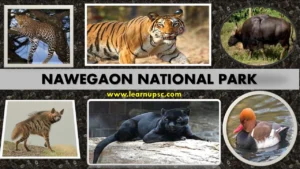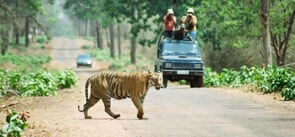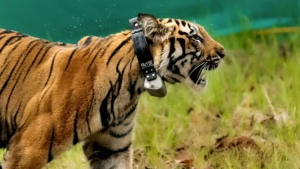
Navegaon Wildlife Sanctuary, a haven for nature lovers. Discover diverse wildlife,lush landscape and peaceful surroundings in this beautiful sanctuary.
Navegaon Wildlife Sanctuary, also known as Navegaon National Park, is a protected area located in the state of Maharashtra, India. It is situated in the Gondia district, approximately 150 kilometers (93 miles) northeast of Nagpur. This sanctuary is known for its rich biodiversity and is a popular destination for wildlife enthusiasts and nature lovers. Here is some key information about Navegaon Wildlife Sanctuary:
1.Geography and Location:
-
- Navegaon Wildlife Sanctuary covers an area of approximately 133.88 square kilometers (51.75 square miles).
- It is located within the central Indian region and is part of the Satpura-Maikal landscape Navegaon is home to a wide range of wildlife species. Some of the prominent animal species found here include:
- Tigers
- Leopards
- Sloth bears
- Indian gaur (bison)
- Sambar deer
- Spotted deer (chital)
- Wild boars
- Barking deer
- Indian giant squirrel
- Various species of reptiles and birds
-
Avifauna:
- The sanctuary is a haven for birdwatchers, with over 60 species of migratory and resident birds.
- The Navegaon Lake within the sanctuary attracts a significant number of waterfowl during the winter months.
- Commonly sighted birds include peafowls, Indian rollers, and drongos.
-
Navegaon Lake:
- The centerpiece of the sanctuary is Navegaon Lake, which is an artificial reservoir created in the 18th century.
- The lake provides water to the wildlife in the area and is also used for boating and other recreational activities.
-
Tourism:
- Navegaon Wildlife Sanctuary is a popular destination for eco-tourism and wildlife safaris.
- Visitors can explore the sanctuary through a network of roads and trails.
- There are watchtowers and viewpoints within the sanctuary that provide excellent opportunities for wildlife viewing and birdwatching.
-
Accommodation:
- The sanctuary has a Forest Rest House and a few eco-friendly resorts where visitors can stay.
-
Best Time to Visit:
- The ideal time to visit Navegaon Wildlife Sanctuary is during the winter months, from October to March, when the weather is pleasant, and wildlife sightings are more common.
-
Conservation:
- The sanctuary is managed by the Maharashtra Forest Department, and efforts are made to protect and conserve the biodiversity of the region.
Please note that it’s essential to check the latest regulations and entry requirements before planning a visit to Navegaon Wildlife Sanctuary, as rules and conditions may change over time. This information is based on my knowledge as of September 2021, and there may have been developments or changes since then.
Navegaon Wildlife Sanctuary: A Hidden Gem in Nature’s Bounty
Located in the picturesque district of Gondia in Maharashtra, Navegaon Wildlife Sanctuary is one of the region’s most treasured natural reserves. This sanctuary is known for its lush landscapes, diverse wildlife, and serene environment. Spanning over 135 square kilometers, it provides a safe haven for numerous species of animals, birds, and plants, making it a key destination for nature lovers, wildlife enthusiasts, and those seeking a peaceful escape from urban life. Its beautiful lakes, dense forests, and abundant flora and fauna make it an ideal location for eco-tourism and a perfect getaway for families, photographers, and trekkers.
In this comprehensive exploration of Navegaon Wildlife Sanctuary, we will delve into its history, key attractions, biodiversity, activities, and the efforts made to preserve this natural wonder.
History of Navegaon Wildlife Sanctuary

The origins of Navegaon Wildlife Sanctuary can be traced back to the late 19th century. The sanctuary, which was established in 1975, initially served as a hunting ground for the British colonialists. However, following India’s independence, the area was recognized for its rich biodiversity and transformed into a protected reserve. It is now considered an essential part of the Western Ghats’ ecological system and is a part of the Central India Biogeographic Zone.
The sanctuary is named after Navegaon Lake, a central feature of the sanctuary. The lake is not only a primary water source for the surrounding wildlife but also enhances the beauty and tranquility of the area. Over the years, efforts have been made to maintain the sanctuary’s natural habitats, improve wildlife protection, and make it accessible to eco-tourists, without compromising its ecological balance.
Key Attractions of Navegaon Wildlife Sanctuary
Navegaon Wildlife Sanctuary is renowned for its lush green forests, clear water lakes, and diverse wildlife. It offers visitors a combination of scenic beauty, adventure, and an opportunity to witness nature at its most pristine.
1. Navegaon Lake
The centerpiece of the sanctuary is the Navegaon Lake, which covers an area of about 11 square kilometers. It provides water to the sanctuary’s flora and fauna, playing a crucial role in maintaining the ecosystem. The lake is not just a lifeline for wildlife but also a popular spot for boating and sightseeing. The sight of boats gliding over the calm water, surrounded by dense forests and hills, is one of the most serene experiences in the sanctuary. Birdwatchers often visit the lake to spot a variety of waterfowl and migratory birds, making it a prime location for photographers.
2. Forest Trails and Treks
The sanctuary is crisscrossed by multiple forest trails, offering the perfect opportunity for nature walks, trekking, and photography. The well-maintained paths take you through dense forests, bamboo groves, and rolling hills, allowing you to connect with nature on a deeper level. If you’re lucky, you might even spot wildlife in their natural habitat, including tigers, leopards, sambar, chital, wild boar, and various species of monkeys.
3. Wildlife Safari
A wildlife safari through Navegaon Wildlife Sanctuary is an unforgettable experience. With the help of trained guides, visitors can explore the sanctuary’s dense forests and biodiversity. The jeep safari offers the chance to encounter a variety of wildlife species in their natural habitat. The sanctuary is home to a rich variety of animals, including tigers, leopards, sloth bears, and Indian bison (gaur). The sanctuary is also rich in reptiles, amphibians, and insects that play an integral role in the local ecosystem.
4. Birdwatching
Bird enthusiasts flock to Navegaon Wildlife Sanctuary due to its impressive bird population. It is a haven for both resident and migratory birds. Among the most commonly sighted birds are Indian Peafowl, eagles, herons, and waterfowl that frequent the lake. The sanctuary is also known for hosting migratory birds during the winter months, making it a great spot for birdwatching.
5. Navegaon Dam
The Navegaon Dam, constructed in 1974, serves both as a water reservoir and a picturesque landmark. It is located near the entrance of the sanctuary and adds to the sanctuary’s beauty, with its flowing waters surrounded by dense forests. The dam area is a popular spot for nature lovers to spend time, enjoy the view, or engage in photography. A visit to the dam offers an ideal opportunity for relaxation, allowing visitors to appreciate the landscape in its most natural form.
Biodiversity of Navegaon Wildlife Sanctuary
The sanctuary is a prime example of India’s rich biodiversity. From towering trees to the smallest insects, the entire ecosystem is a balanced and thriving network of life.
Flora
The flora of Navegaon Wildlife Sanctuary is a mixture of tropical dry deciduous forest and grasslands. The trees here include species like Teak, Sal, Bamboo, and Mahua, which contribute to the thick forests. The presence of medicinal plants and shrubs adds to the ecological diversity of the area. Wildflowers bloom in the sanctuary during different seasons, adding a splash of color to the landscape.
The sanctuary is also home to various species of fruit-bearing plants, which provide nourishment for the wildlife. Tamarind, Amla, and Bael trees are often seen in the region, attracting a variety of herbivores and insects. These plants not only contribute to the food chain but also serve as crucial sources of food for the wildlife.
Fauna
Navegaon Wildlife Sanctuary is a haven for wildlife, and its biodiversity is extensive. The sanctuary is home to several species of mammals, birds, reptiles, and insects. Some of the prominent species found in the sanctuary include:
- Tigers: Navegaon is one of the few places where you can spot tigers in their natural habitat.
- Leopards: These elusive and beautiful predators are commonly found in the sanctuary.
- Sloth Bears: Known for their distinctive look and habits, sloth bears are another major attraction in the sanctuary.
- Chital (Spotted Deer): These elegant creatures are frequently seen grazing or roaming in herds.
- Sambar: The sanctuary is home to a healthy population of these large herbivores.
- Wild Boar: Commonly found in the region, these boars play an important role in maintaining the ecological balance.
- Indian Bison (Gaur): These majestic animals, which are the largest of the wild cattle species, can be spotted in the sanctuary.
Additionally, the sanctuary is home to several species of reptiles, including snakes, lizards, and turtles, all of which contribute to the ecological balance by keeping smaller creatures in check.
Activities in Navegaon Wildlife Sanctuary

The sanctuary offers a variety of activities for visitors to enjoy and experience the beauty of nature.
1. Boating
The serene Navegaon Lake is a perfect spot for boating. Tourists can take a leisurely boat ride across the lake and soak in the scenic views of the surrounding forested hills. It’s a peaceful activity that allows visitors to get close to nature.
2. Photography
Whether you’re an amateur or a professional photographer, Navegaon Wildlife Sanctuary offers countless opportunities for capturing nature’s beauty. The diverse flora and fauna, serene lakes, and dramatic landscapes provide the perfect backdrop for stunning photographs. Birdwatchers and wildlife photographers often flock to the sanctuary to capture rare sightings of birds and animals.
3. Trekking and Hiking
For adventure enthusiasts, the sanctuary offers several trekking and hiking trails. These trails take visitors through dense forests, across streams, and up to hilltops with panoramic views of the sanctuary. Trekking in this environment allows nature lovers to experience the sanctuary in its raw and untamed form.
4. Nature Walks
Guided nature walks are also available, where experienced naturalists take tourists through the sanctuary, explaining the flora, fauna, and the ecosystem. It’s an educational activity that provides a deeper understanding of the sanctuary’s environmental significance.
Conservation Efforts at Navegaon Wildlife Sanctuary
The preservation of Navegaon Wildlife Sanctuary is a collective effort, and various conservation initiatives have been put in place to ensure the protection of its ecosystems and wildlife. The sanctuary is managed by the Maharashtra Forest Department, which enforces strict measures to combat poaching and habitat destruction.
In addition to regular wildlife patrols, the sanctuary focuses on anti-poaching campaigns and wildlife monitoring. Furthermore, the sanctuary collaborates with local communities to raise awareness about the importance of protecting the environment.
The Importance of Navegaon Wildlife Sanctuary in Conservation
Navegaon Wildlife Sanctuary plays an important role in conservation, not only because of its diverse ecosystem but also due to its location within the larger network of wildlife reserves in Maharashtra and Central India. It helps preserve crucial species of plants, animals, and birds, many of which are either endangered or threatened. By protecting these species and their habitats, the sanctuary contributes significantly to the region’s biodiversity conservation efforts.
Habitat Preservation and Restoration
One of the primary conservation goals at Navegaon is to ensure the preservation and restoration of its natural habitats. The sanctuary’s diverse forests, grasslands, and water bodies provide essential ecosystems for the species that live there. The presence of forests and waterways allows for the successful breeding and survival of animals such as tigers, leopards, and wild boar, which rely on undisturbed environments to thrive.
The sanctuary is also working to restore habitats that have been affected by human activities or natural disasters. Through efforts such as reforestation and improved water management practices, the sanctuary’s management works to maintain a balance that ensures both flora and fauna can continue to flourish. The sanctuary focuses on sustainable management of resources, aiming to maintain ecological integrity while also catering to the increasing number of eco-tourists who visit every year.
Educational and Research Opportunities
Navegaon Wildlife Sanctuary serves as a hub for ecological research and education. Many researchers and students from around the world visit to study its unique ecosystem. The sanctuary’s management encourages the involvement of local communities in these research initiatives, fostering a sense of responsibility toward wildlife conservation. By providing educational resources and research opportunities, the sanctuary helps raise awareness about environmental issues and conservation techniques.
The sanctuary also collaborates with non-governmental organizations (NGOs) and other conservation groups to implement wildlife monitoring programs, conduct ecological surveys, and develop wildlife protection strategies. These initiatives are essential in ensuring the long-term survival of both the sanctuary’s native species and its overall ecosystem.
The Role of Local Communities
Local communities surrounding the sanctuary play an important role in its success. Sustainable practices, including eco-tourism and responsible farming, help reduce the negative impact on the environment. Many locals are employed as guides, wardens, and other staff, contributing to both the economy and the conservation efforts. By involving local communities in the sanctuary’s conservation initiatives, the sanctuary fosters a sense of ownership, helping reduce illegal activities like poaching and deforestation.
Educational programs and awareness campaigns aim to inform locals about the benefits of preserving their natural resources and wildlife. By creating partnerships with communities, Navegaon Wildlife Sanctuary has managed to cultivate a mutually beneficial relationship that allows both humans and wildlife to thrive.
Eco-Tourism and Its Benefits
Eco-tourism is a significant driver of sustainable development at Navegaon Wildlife Sanctuary. Visitors flock to the sanctuary not just to observe wildlife but also to enjoy a range of eco-friendly activities such as boating, trekking, birdwatching, and photography. This tourism generates much-needed revenue for the sanctuary, which can be reinvested into conservation efforts. Additionally, eco-tourism helps educate visitors about the importance of preserving the environment and respecting wildlife.
The sanctuary also benefits from the tourism infrastructure, including lodging, transportation, and guides, which are carefully managed to ensure minimal impact on the environment. By promoting responsible tourism, Navegaon ensures that it remains a sanctuary for wildlife and a place of natural beauty for generations to come.
The Future of Navegaon Wildlife Sanctuary
Looking ahead, Navegaon Wildlife Sanctuary faces both challenges and opportunities. While conservation efforts have been successful in many areas, the growing pressures of climate change, illegal poaching, and habitat destruction remain constant threats to the sanctuary’s delicate ecosystem. However, there is optimism that continued awareness, education, and conservation work will allow the sanctuary to overcome these challenges.
In the future, there may be an increased focus on expanding the sanctuary’s boundaries, ensuring even larger areas of protected land for wildlife to roam freely. The introduction of advanced technologies, such as camera traps and wildlife tracking systems, will also aid in monitoring species and protecting against illegal activities like poaching. Additionally, promoting further collaboration with national and international wildlife conservation organizations can help ensure the sanctuary’s continued success.
The increasing popularity of eco-tourism in India also holds great potential for Navegaon Wildlife Sanctuary, as more visitors are drawn to natural destinations that offer both beauty and educational value. This could lead to additional funding for conservation efforts and raise awareness about the importance of preserving India’s natural heritage.
Conclusion
Navegaon Wildlife Sanctuary is more than just a place for tourists to enjoy nature—it is an essential part of India’s environmental heritage. The sanctuary’s breathtaking landscapes, abundant wildlife, and rich biodiversity make it one of the country’s most treasured wildlife reserves. Through conservation efforts, educational initiatives, and the involvement of local communities, Navegaon Wildlife Sanctuary stands as a testament to the power of nature and the importance of preserving our natural world.
As the sanctuary continues to evolve, it will undoubtedly play a crucial role in safeguarding not only the species within its boundaries but also in protecting the delicate ecosystems of the surrounding region. For those lucky enough to visit, the experience of witnessing the unspoiled beauty of Navegaon Wildlife Sanctuary is a reminder of why protecting such places is so vital to our planet’s future. Whether you are an eco-tourist, a nature enthusiast, or a conservationist, a visit to Navegaon offers more than just an adventure—it offers a connection to something much larger: the health of our planet and the wildlife that depend on it.







Recent Comments